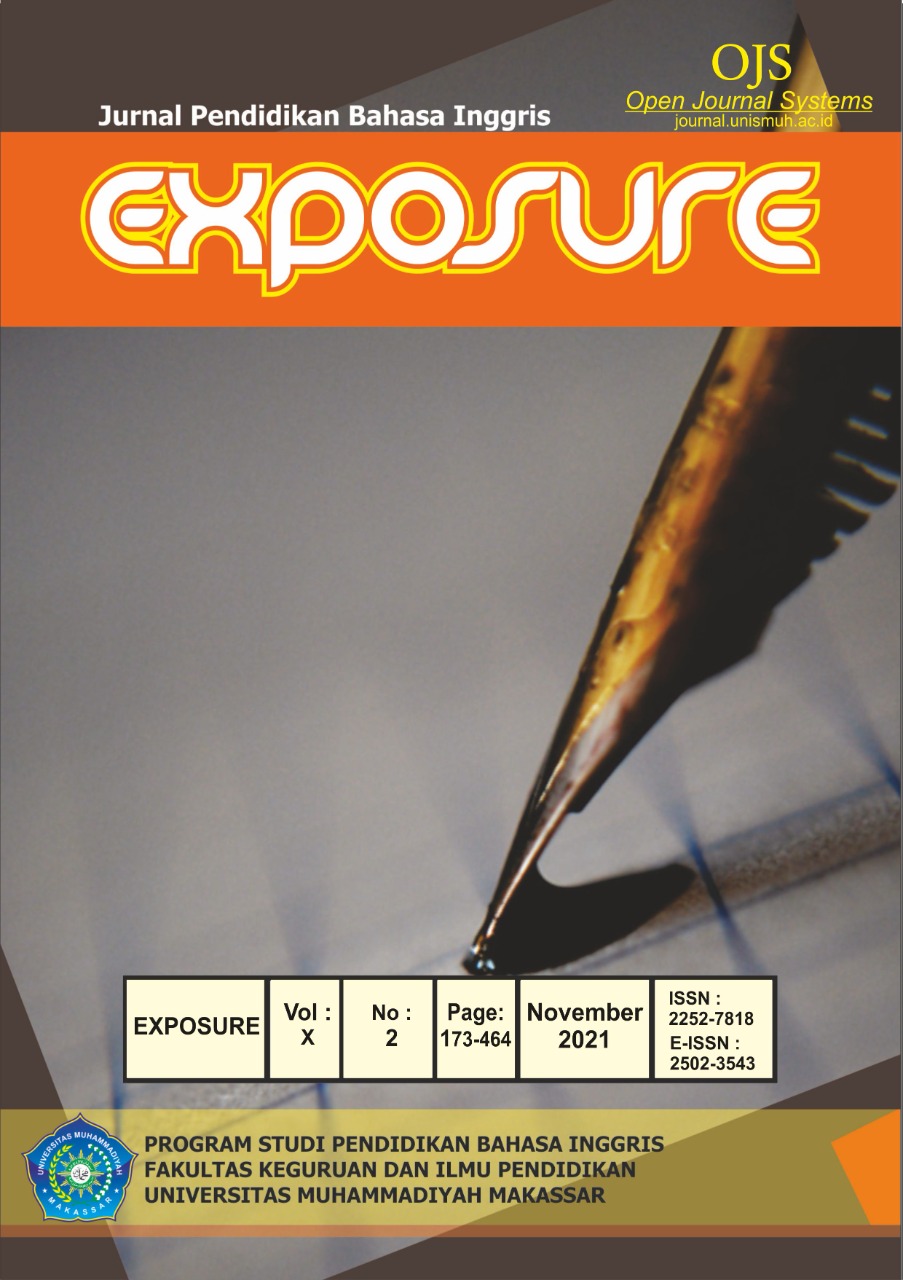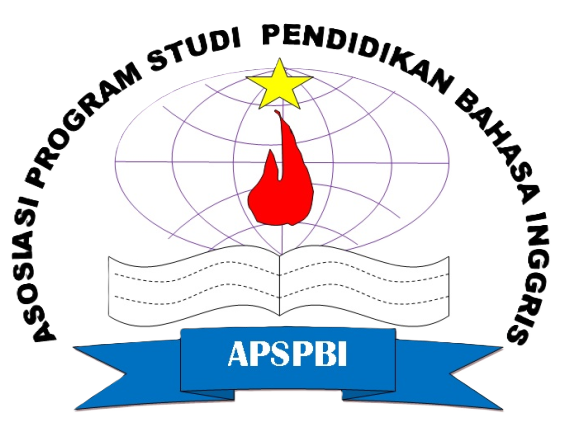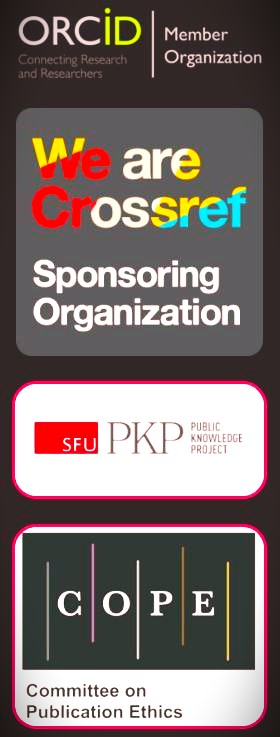EFL students’ long-term practice of Data-driven Learning
DOI: https://doi.org/10.26618/exposure.v10i2.6173
Data-driven Learning, EFL students, corpora
Abstract
Data-driven Learning (DDL) has been widely used in language classrooms and suggested to promote learner autonomy and retention. The current study would confirm if the findings of research in other countries are also found in Indonesian context within different time span. Therefore, this study investigates Indonesian EFL students’ long-term practice of DDL after one semester has passed since they learned with DDL using corpus data. The participants of this study were university students specializing in English Language Education and the setting of this study was at one public university in Central Kalimantan Province of Indonesia where English is a foreign language. Survey research with one-shot design was conducted and questionnaire comprising of three dimensions (learners’ retention of learning materials and current knowledge of DDL, current practice of DDL, and future plan) was distributed to collect data. The results show positive trends that the students had retention of the learning materials they learned in the previous semester through DDL, they currently employed DDL independently outside classrooms, and they would apply DDL in the future.
References
Alfieri, L., Brooks, P. J., Aldrich, N. J., & Tenenbaum, H. R. (2011). Does discovery-based instruction enhance learning? Journal of Educational Psychology, 103(1), 1–18. https://doi.org/10.1037/a0021017
Boontam, P., & Phoocharoensil, S. (2018). Effectiveness of English preposition learning through data-driven learning (DDL). 3L: Language, Linguistics, Literature, 24(3), 125–141. https://doi.org/10.17576/3L-2018-2403-10
Boulton, A., & Cobb, T. (2017). Corpus use in language learning: A meta-analysis. Language Learning, 67(2), 348–393. https://doi.org/10.1111/lang.12224
Chambers, A. (2010). What is data-driven learning? In A. O’Keeffe & M. McCarthy (Eds.), The Routledge handbook of corpus linguistics (pp. 345–358). Routledge.
Chang, J.-Y. (2014). The use of general and specialized corpora as reference sources for academic English writing: A case study. ReCALL, 26(2), 243–259. https://doi.org/10.1017/S0958344014000056
Daskalovska, N. (2015). Corpus-based versus traditional learning of collocations. Computer Assisted Language Learning, 28(2), 130–144. https://doi.org/10.1080/09588221.2013.803982
Ebrahimi, A., & Faghih, E. (2017). Integrating corpus linguistics into online language teacher education programs. ReCALL, 29(1), 120–135. https://doi.org/10.1017/S0958344016000070
Friginal, E. (2013). Developing research report writing skills using corpora. English for Specific Purposes, 32(4), 208–220. https://doi.org/10.1016/j.esp.2013.06.001
Geluso, J., & Yamaguchi, A. (2014). Discovering formulaic language through data-driven learning: Student attitudes and efficacy. ReCALL, 26(2), 225–242. https://doi.org/10.1017/S0958344014000044
Gilquin, G., & Granger, S. (2010). How can data-driven learning be used in language teaching? In A. O’Keeffe & M. McCarthy (Eds.), The Routledge handbook of corpus linguistics (pp. 359–370). Routledge.
Gordani, Y. (2013). The effect of the integration of corpora in reading comprehension classrooms on English as a Foreign Language learners’ vocabulary development. Computer Assisted Language Learning, 26(5), 430–445. https://doi.org/10.1080/09588221.2012.685078
Johns, T. (1991). Should you be persuaded: Two examples of data-driven learning. ELR Journal, 4, 1–16. https://lexically.net/wordsmith/ corpus_linguistics_links/Tim Johns and DDL.pdf.
Karras, J. N. (2016). The effects of data-driven learning upon vocabulary acquisition for secondary international school students in Vietnam. ReCALL, 28(2), 166–186. https://doi.org/10.1017/S0958344015000154
Kennedy, C., & Miceli, T. (2017). Cultivating effective corpus use by language learners. Computer Assisted Language Learning, 30(1–2), 91–114. https://doi.org/10.1080/09588221.2016.1264427
Larsen-Walker, M. (2017). Can Data Driven Learning address L2 writers’ habitual errors with English linking adverbials? System, 69(October 2017), 26–37. https://doi.org/10.1016/j.system.2017.08.005
Lee, H., Warschauer, M., & Lee, J. H. (2019). The effects of corpus use on second language vocabulary learning: A multilevel meta-analysis. Applied Linguistics, 40(5), 721–753. https://doi.org/10.1093/applin/amy012
Lee, H., Warschauer, M., & Lee, J. H. (2020). Toward the Establishment of a Data-Driven Learning Model: Role of Learner Factors in Corpus-Based Second Language Vocabulary Learning. Modern Language Journal, 104(2), 345–362. https://doi.org/10.1111/modl.12634
Lin, M. H. (2016). Effects of corpus-aided language learning in the EFL grammar classroom: A case study of students’ learning attitudes and teachers’ perceptions in Taiwan. TESOL Quarterly, 50(4), 871–893. https://doi.org/10.1002/tesq.250
Lin, M. H., & Lee, J.-Y. (2015). Data-driven learning: Changing the teaching of grammar in EFL classes. ELT Journal, 69(3), 264–274. https://doi.org/10.1093/elt/ccv010
Luo, Q. (2016). The effects of data-driven learning activities on EFL learners’ writing development. SpringerPlus, 5(1255), 1–13. https://doi.org/10.1186/s40064-016-2935-5
Moon, S., & Oh, S.-Y. (2017). Unlearning overgenerated be through data-driven learning in the secondary EFL classroom. ReCALL, 30(1), 48–67. https://doi.org/10.1017/S0958344017000246
Nugraha, S. I., Miftakh, F., & Wachyudi, K. (2017). Teaching grammar through Data-Driven Learning (DDL) approach. 82(Conaplin 9), 300–303. https://doi.org/10.2991/conaplin-16.2017.68
Pérez-Paredes, P. (2019). A systematic review of the uses and spread of corpora and data-driven learning in CALL research during 2011–2015. Computer Assisted Language Learning, 0(0), 1–26. https://doi.org/10.1080/09588221.2019.1667832
Pham, Q. H. P. (2020). A Corpus-Based Approach to Grammar Instruction in IELTS Writing Classes. RELC Journal. https://doi.org/10.1177/0033688220952170
Tomlinson, B. (2018). Discovery-based instruction. The TESOL Encyclopedia of English Language Teaching, 1–6. https://doi.org/10.1002/9781118784235.eelt0057
Tono, Y., Satake, Y., & Miura, A. (2014). The effects of using corpora on revision tasks in L2 writing with coded error feedback. ReCALL, 26(2), 147–162. https://doi.org/10.1017/S095834401400007X
Downloads
Published
How to Cite
Issue
Section
License
Authors who publish with this journal agree to the following terms:
In order to assure the highest standards for published articles, a peer review policy is applied. In pursue of the compliance with academic standards, all parties involved in the publishing process (the authors, the editors and the editorial board and the reviewers) agree to meet the responsibilities stated below in accordance to the Journal publication ethics and malpractice statement.
Duties of Authors:
- The author(s) warrant that the submitted article is an original work, which has not been previously published, and that they have obtained an agreement from any co-author(s) prior to the manuscript’s submission;
- The author(s) should not submit articles describing essentially the same research to more than one journal;
- The authors(s) make certain that the manuscript meets the terms of the Manuscript Submission Guideline regarding appropriate academic citation and that no copyright infringement occurs;
- The authors(s) should inform the editors about any conflict of interests and report any errors they subsequently, discover in their manuscript.
Duties of Editors and the Editorial Board:
- The editors, together with the editorial board, are responsible for deciding upon the publication or rejection of the submitted manuscripts based only on their originality, significance, and relevance to the domains of the journal;
- The editors evaluate the manuscripts compliance with academic criteria, the domains of the journal and the guidelines;
- The editors must at all times respect the confidentiality of any information pertaining to the submitted manuscripts;
- The editors assign the review of each manuscript to two reviewers chosen according to their domains of expertise. The editors must take into account any conflict of interest reported by the authors and the reviewers.
- The editors must ensure that the comments and recommendations of the reviewers are sent to the author(s) in due time and that the manuscripts are returned to the editors, who take the final decision to publish them or not.
Authors are permitted and encouraged to post online a pre-publication manuscript (but not the Publisher’s final formatted PDF version of the Work) in institutional repositories or on their Websites prior to and during the submission process, as it can lead to productive exchanges, as well as earlier and greater citation of published work (see The Effect of Open Access). Any such posting made before acceptance and publication of the Work shall be updated upon publication to include a reference to the Publisher-assigned DOI (Digital Object Identifier) and a link to the online abstract for the final published Work in the Journal.














